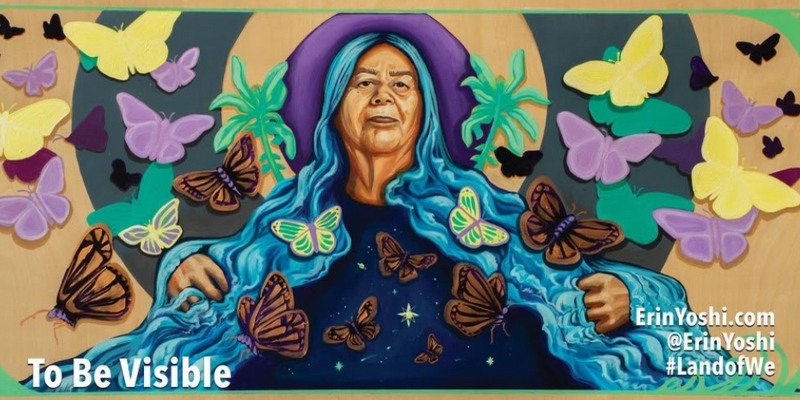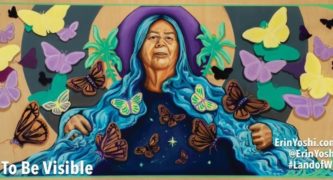
Julia Louise “Wiseone” Bogany, a teacher, activist and member of the local indigenous Tongva tribe, passed away on March 28 at Redlands Community Hospital due to complications associated with a stroke that she suffered on March 7. She was 72.
A GoFundMe page was set up to help cover medical and funeral bills, which raised $75,890 out of a $65,000 goal, as of April 8. Bogany is survived by her husband Andrew, who is diagnosed with Alzheimer’s, as well as four children, 10 grandchildren and 11 great-grandchildren. Leftover funds will go to support Andrew’s care.
“Our beloved Julia has gone to meet her father in heaven this morning,” Joseph Aranda, organizer of the GoFundMe page, wrote on March 28. “God bless you Julia and thank you for all that you have done for us! We truly love and will miss you!”
Aranda announced that Bogany’s funeral service will be held at 10 a.m. Saturday, April 17, followed by burial at approximately 11:15 a.m. at Mt. View Mortuary & Cemetery, 570 E. Highland Ave., San Bernardino. Due to the pandemic, there will be a capacity restriction of 65 people inside the chapel, with family taking priority for the indoor service followed by first come availability. Remaining attendees will be directed to wait at the burial site or outside the chapel. The service will also be livestreamed. Aranda will post the livestream link on the GoFundMe page soon.
“I always say Tongva women never left their ancestral homeland, they just became invisible,” Bogany was quoted as saying on her website ToBeVisible.org. “‘How do we make ourselves not invisible?’ is the question I ask every day.”
Bogany was a member of the Tongva Tribal Council and served as the tribe’s cultural consultant. She was dedicated to the teaching, revitalization and visibility of Tongva language and culture throughout the San Gabriel Valley and surrounding communities, which she did for more than 30 years. She was an elder-in-residence who taught native culture and history and women’s issues at the Claremont Colleges, including Scripps, Pomona, Harvey Mudd, Pitzer and the Claremont School of Theology. She worked to “reawaken and revive the Tongva language, as well as assemble a Tongva dictionary,” according to her website.
Bogany is well known throughout the Southland for her work. At Cal State, Dominguez Hills, there is a 47-foot mural of her. She was president of Kuruvanga Springs, a representative for California tribes on Route 66 and a member of the California Native American College board. She also served as vice president of the Keepers of Indigenous Ways, a nonprofit group of the Tongva, and president of Residential Motivators, her own nonprofit consulting firm.
In November, Bogany delivered a virtual talk hosted by the Pasadena Public Library about the Tongva people’s history and culture, one of the last events of her storied career.
Kimberly Morales Johnson, Bogany’s cousin and a fellow Tribal Council member, told LAist that Bogany “would start sometimes at 5 o’clock in the morning and not get home until 10 o’clock at night. Just all on her quest to make sure that people knew who the Gabrielino-Tongva were, and that we are still here, and that we still exist.”
Archeologists estimate that the Tongva have been in Southern California since between 4,500 to 10,000 years ago. For their homes, tribe members built thatched dome structures called Kiiy using poles, white willow and tule-reeds in the LA Basin, including along the banks of the seasonal Arroyo Seco and throughout the San Gabriel Valley, as well as on the Channel Islands. Coastal and island tribes made their Kiiy out of whale ribs and reeds.
“The Arroyo Seco was really the cradle of civilization for Indians that inhabited Pasadena and South Pasadena,” South Pasadena City Librarian Steve Fjeldsted told this reporter in 2013. “It not only gave them their water but was also part of their trade and travel routes. Of course, later it became one of the first routes between Pasadena and Los Angeles.”
Tongva tribe members lived throughout modern-day Los Angeles County, in a territory totaling more than 2,500 square miles. An estimated 2,000 descendants still live in the area today. Because of their location near the ocean and between other Native American groups, the Tongva traded with neighbors based on an economy of acorns, clamshell beads and wild plant foods.
According to Tongva educator Craig Torres, the name Tongva “comes from a word in our language which means ‘the earth’ or ‘the land’ or ‘one’s landscape,’ so it translates to ‘people of the earth.’”
According to Bogany’s website, the Tongva, later named Gabrielinos by the Spaniards, “lived in communities based on family ties, a notion that is still important to the Gabrielino-Tongva today. Multiple communities organized themselves into larger groups that governed social, political and economic interactions. The Gabrielino-Tongva were primarily hunter-gatherers who changed location within the seasons, while the communities on the islands and coastline used canoes, called Tiats, to go deep-sea fishing. The Gabrielino-Tongva people have a rich oral history full of legends and stories.”
Their language had Uto-Aztecan roots and they “were the source of the jimsonweed cult, a widely practiced Southern California religion that involved various sacred and esoteric rituals and the drinking of toloache, a hallucinogen made from the jimsonweed (Datura stramonium),” according to Britannica. “Each Gabrielino village had a hereditary chief; shamanism was an important part of Gabrielino religion and healing practices.”
They also made baskets, and according to LAist, Bogany consulted with artists on public art projects such as the Metro Gold Line Bridge built over the 210 freeway between Pasadena and Arcadia in 2010, which “has support columns that emulate Gabrielino-Tongva baskets.”
When Spanish explorers began colonizing the area in the 18th century, Native American culture was absorbed by the missionaries. California became a Mexican province when Mexico won independence from Spain. According to the definitive historical text by Jane Apostol, “South Pasadena: A Centennial History,” very few Native Americans received shares of land “when the property once controlled by the missions was given away in huge land grants on which ranchos were established.” Most of present-day Altadena, Pasadena, San Marino and South Pasadena formed the boundaries of Rancho San Pasqual.
According to KCRW, “when the Spanish arrived in Southern California in the late 1700s, life as the Tongva knew it was over. From that point on, the history of the Tongva and of all indigenous people in California, is an incredibly painful one — wrought with stories of mass killing, stolen land and stolen identity. The Spanish settlers arrived and built the Mission San Gabriel in 1781. Thousands of Tongva were forced to leave their villages to work and live in the Missions. The missionaries collectively called all natives ‘Gabrielinos.’ The Tongva and other tribes were baptized, forced to give up their language and their culture. The tribes fought back fiercely. But as bad as things were under the Spanish, the slaughter only increased when California became a state in 1850.”
But much of that history is largely unknown by most Californians. That’s why Bogany “consulted with and trained teachers and school boards on how to revise their curriculum to reflect the correct history of California and California tribes,” according to her website.
It wasn’t until 1994 that California state law finally recognized the Gabrielino-Tongva, but the tribe still didn’t receive federal recognition or assistance. Read a timeline of the tribe’s history here.
Bogany wanted to “change the future for her tribe, children, grandchildren, and great grandchildren; this is her way of doing it. All the work she’s done for the past 20 years is for their future and for the future of her Tongva tribe.”
A statement by some of her colleagues Gina Lamb, Tricia Morgan, Tessa Hicks Peterson, Susan Phillips, Erich Steinman and her students at the Claremont Colleges, paid tribute to her legacy.
“Her work to uplift, revitalize, and decolonize the legacy of the Native Americans on whose land we have settled (the Tongva) has made a huge impact not only locally and nationally, but specifically in the educational and social justice work of Pitzer (and Pomona, as well),” read the statement. “We’d like to honor her work and support her family, in this time of need.”



















One thought on “Local Tongva Tribe Elder and Community Activist Julia ‘Wiseone’ Bogany Dies at 72”
I taught CA History (4th grade) for one year & was disappointed so much emphasis was devoted to the Spanish Explorers, Priests, & Missions, and very little on the Gabrielino Tongva . The contribution of
the Chinese people is barely covered at the end of the book.
Our history books need to be revised to include this history.